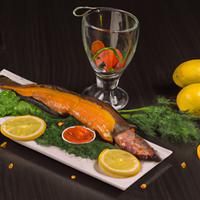
1 serving (100 grams) contains 250 calories, 20.0 grams of protein, 20.0 grams of fat, and 0.0 grams of carbohydrates.

Log this food in SnapCalorie

Nutrition Information
Calories |
595.2 | ||
|---|---|---|---|
% Daily Value* |
|||
| Total Fat | 47.6 g | 61% | |
| Saturated Fat | 19.0 g | 95% | |
| Polyunsaturated Fat | 0 g | ||
| Cholesterol | 166.7 mg | 55% | |
| Sodium | 166.7 mg | 7% | |
| Total Carbohydrates | 0 g | 0% | |
| Dietary Fiber | 0 g | 0% | |
| Sugars | 0 g | ||
| protein | 47.6 g | 95% | |
| Vitamin D | 0 mcg | 0% | |
| Calcium | 23.8 mg | 1% | |
| Iron | 4.8 mg | 26% | |
| Potassium | 714.3 mg | 15% | |
* Percent Daily Values are based on a 2,000 calorie diet. Your daily values may be higher or lower depending on your calorie needs.
Food Attributes
Source of Calories
About Lammlachs
Lammlachs, deriving from German and Austrian cuisine, refers to tender cuts of lamb often taken from the loin area. Known for its mild, rich flavor and delicate texture, Lammlachs is a premium choice within lamb dishes. This lean and protein-rich meat is an excellent source of essential nutrients, including iron, zinc, and B vitamins, which support energy levels and immune function. While lamb is higher in fat compared to poultry or lean beef, Lammlachs typically contains less fat if carefully trimmed, making it a healthier choice among lamb cuts. However, moderation is key due to its saturated fat content, which can impact heart health if consumed excessively. Versatile and flavorful, Lammlachs can be grilled, roasted, or pan-seared, often accompanied by vegetables, herbs, or light sauces for a balanced meal that highlights its nutritional and culinary appeal.



